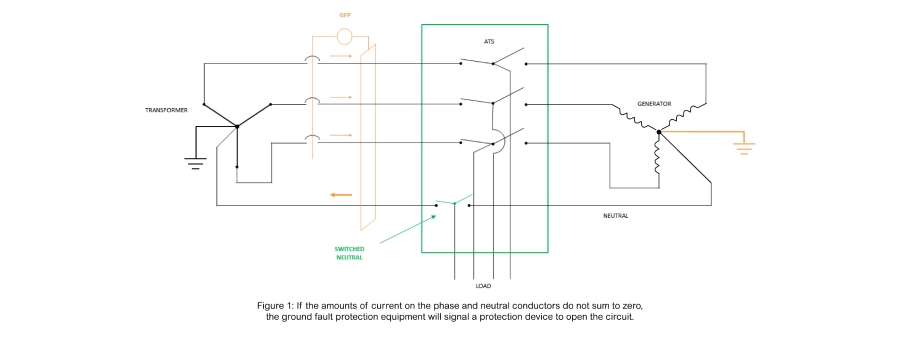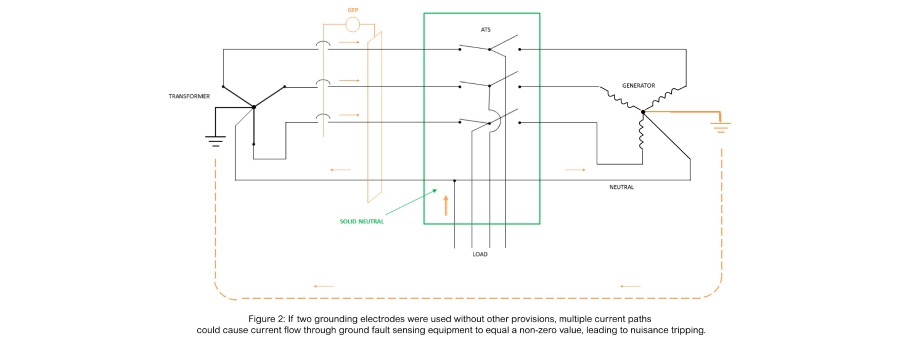For this reason, a switched neutral can be used in the ATS to isolate the neutral of the unconnected power source. This is the arrangement shown is Figure 1.
Key Electrical Code Requirements
Article 250.20(B) of the 2020 NEC sets forth requirements for grounding alternating current systems where transformers supply 50 to 100 Volts. In addition, Article 250.30 sets forth requirements for grounding separately derived systems, which is first defined in Article 100 as follows:
Separately Derived System.
An electrical source, other than a service, having no direct connection(s) to circuit conductors of any other electrical source other than those established by grounding and bonding connections.
Thus, where a backup generator neutral conductor is grounded to a dedicated nearby electrode, it forms a separately derived system. As such, Article 230 goes on to state:
250.30 Grounding Separately Derived Alternating-Current Systems.
In addition to complying with 250.30(A) for grounded systems, or as provided in 250.30(B) for ungrounded systems, separately derived systems shall comply with 250.20, 250.21, 250.22, or 250.26, as applicable.
Consequently, separately derived systems are those that are not connected to the primary electrical service, and thus require a dedicated grounding electrode.
Following Article 250.30, the NEC provides an informational note that bears on the application:
Informational Note No. 1: An alternate ac power source, such as an on-site generator, is not a separately derived system if the grounded conductor is solidly interconnected to a service-supplied system grounded conductor. An example of such a situation is where alternate source transfer equipment does not include a switching action in the grounded conductor and allows it to remain solidly connected to the service-supplied grounded conductor when the alternate source is operational and supplying the load served.
Consequently, where a generator neutral is bonded to the neutral of the electrical service of a building, the entire system is considered to be singular, not separately derived, and could use a single grounding electrode.
Transferring between Two Neutral Conductors
When the generator neutral is bonded to the service neutral, these conductors are solidly connected at the transfer switch, which switches only the phase conductors. This is the typical configuration of standard transfer switch models.
For separately derived systems, manufacturers also offer transfer switches that switch the neutral conductor together with the phase conductors. Using a switched neutral isolates the ground conductor of the unconnected power source to avoid ground current pathway problems. Again, a switched neutral is shown in Figure 1.
Key Indicators
Viewing all of the prior information in context, systems in the range of 150 to 1000 volts exceeding 1000 Amps require ground fault sensing. Proper sensing will commonly require a dedicated ground at the generator and a switched neutral at the transfer switch.
For applications below 1000 Amps where a generator neutral is grounded back to the service entrance, only one grounding electrode is used. This requires a transfer switch with solid neutral connection. However, designers may need to consider other factors to confirm whether to ground the generator directly. Two of them are identified below:
- If a system below 1000 Amps is being fitted with backup power because it serves a mission-critical function, would ground fault protection be advantageous to the application? If yes, then a separately derived system may still be warranted and a switched neutral transfer switch may be used.
- If the generator is located far from a service entrance, it may be desirable to install a dedicated grounding electrode near the genset to avoid energizing a long conductor during a fault. In addition, a cable cut along the length of the grounding conductor could leave a running generator ungrounded, resulting in unsafe conditions. Designers might consider using a dedicated grounding electrode near the generator to avoid these conditions. Again, a separately derived system may be warranted and a switched neutral transfer switch may be used.
Closing
The information herein illustrates the most basic factors involved in deciding how to ground a genset. In practice, grounding issues, grounding and ground fault system designs, and the responding codes can be far more complex. Situations requiring special consideration include applications with multiple transfer switches, multiple gensets, lightning protection systems, and mobile or portable generators. Qualified electrical professionals should be used to evaluate grounding needs and specify responding designs. Further information can be reviewed in the references that follow. Representatives of ASCO Power Technologies can be consulted to obtain supporting information for specific applications.
References
National Fire Protection Association:
NFPA 70 - National Electrical Code
ASCO Tech Brief:
Managing Ground Faults in Backup Power Systems
ASCO White Paper:
Switching the Neutral Conductor



